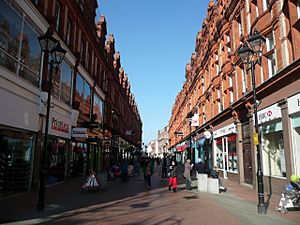Queen Victoria Street, Reading facts for kids

View north towards Reading railway station
|
|
| Location | Reading, Berkshire, UK |
|---|---|
| Postal code | RG1 |
| Coordinates | 51°27′22.44″N 0°58′19.63″W / 51.4562333°N 0.9721194°W |
| Construction | |
| Completion | 1903 |
Queen Victoria Street is a busy street in the town of Reading, England. It's a special kind of street where only people can walk, because it's a pedestrianised area. This means no cars are allowed! The street connects three other important roads: Broad Street, Friar Street, and Station Road. It's a popular spot for shopping and exploring in Reading.
History of Queen Victoria Street
Queen Victoria Street is not as old as some other parts of Reading. It was built in the early 1900s, which is the start of the 20th century. The main reason for building this street was to create a direct path from Broad Street to Station Road. This made it much easier for people to get to Reading's railway station, which had opened many years earlier in 1840.
Who Helped Build the Street?
A local businessman named Councillor J.C. Fidler was the person who made this street happen. He was a very important person in Reading at the time. Councillor Fidler did many other great things for the town too. He helped rebuild another street called West Street and created the Market Arcade. He also helped the town buy Prospect Park, which is a large park for everyone to enjoy.
Councillor Fidler was still working on Queen Victoria Street when he passed away in 1903. The street was almost finished by then, a lasting reminder of his contributions to Reading.
What Was There Before?
To build Queen Victoria Street, some older buildings had to be taken down. These buildings were on both Friar Street and Broad Street. One of the places that was removed was called Laud Place. This was a group of homes built in 1813.
Laud Place was special because it was built on the spot where a very important historical figure was born. This person was William Laud, who became the Archbishop of Canterbury. He was born in Reading in 1573.

